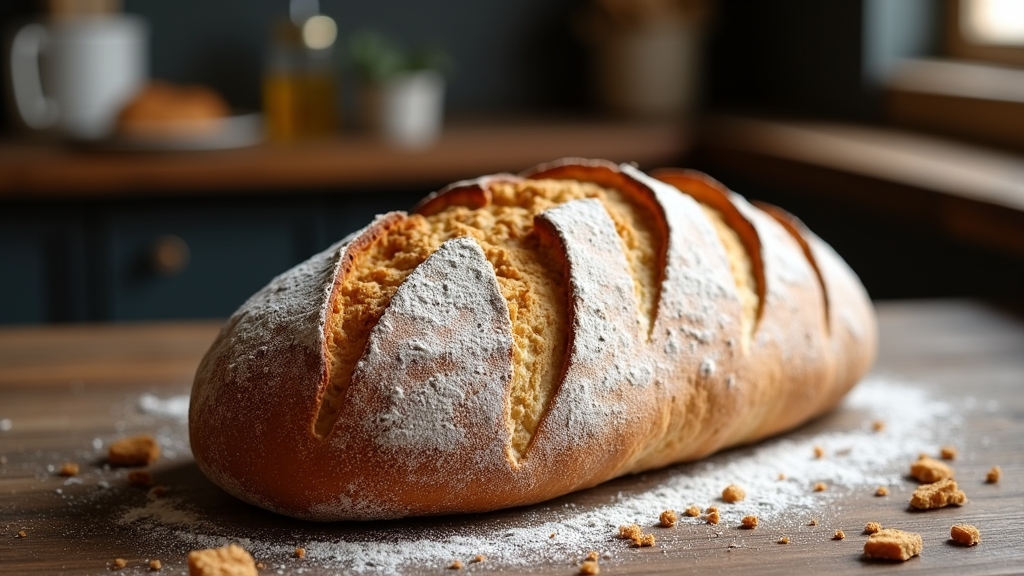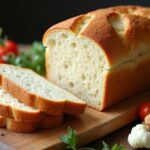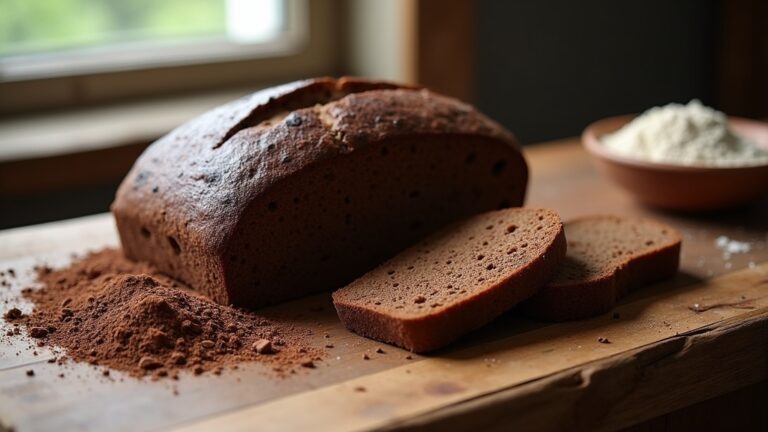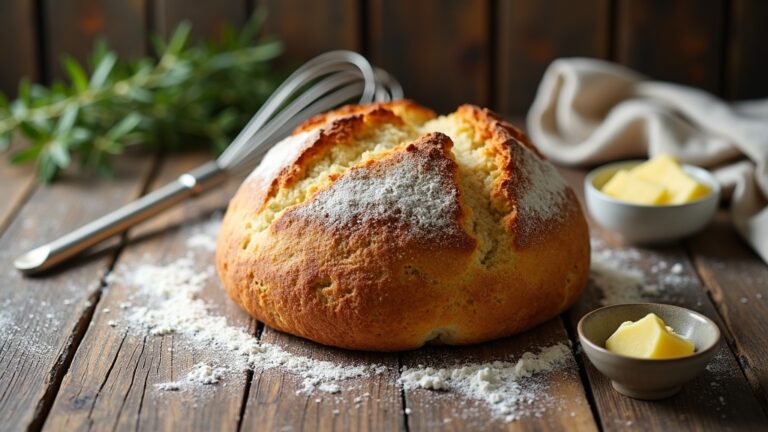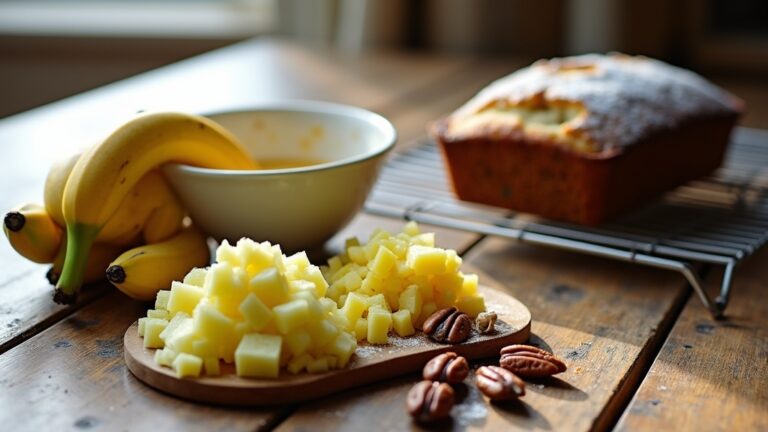Sweet Sourdough Bread Recipe
I’ve discovered a delightful twist on traditional sourdough by infusing it with sweet notes that tantalize the taste buds. Start by mixing an active starter with lukewarm water, then blend in rich whole wheat and bread flours, coconut sugar for a subtle sweetness, and a dash of vanilla for depth. After kneading into a smooth, elastic dough and allowing it to properly rise, you get a beautifully textured loaf with a perfect balance of sweet and tangy. The secrets to perfecting this recipe await in the next steps.
Contents
History
While the precise origins of sourdough remain shrouded in mystery, it is understood that this beloved bread has nourished communities for thousands of years. The magic of sourdough begins with ancient fermentation, a process harnessing wild yeasts and bacteria to transform simple flour and water into a complex, flavorful loaf. Sourdough’s origins tap into a deep-rooted culinary tradition, likely dating back to ancient Egypt. Imagine, ancient bakers unknowingly capturing wild yeast from the air, their techniques and recipes passing through generations, each iteration refining the art. This time-honored method not only predates modern baking but also embodies a living link to our past, making each crusty loaf a reflection of human ingenuity and the timeless quest for sustenance.
Recipe
Sourdough bread is a delightful artisan bread known for its tangy flavor, chewy texture, and crisp crust. Unlike other breads, sourdough doesn’t require commercial yeast. Instead, it relies on a ‘starter’ – a fermented mixture of flour and water that captures wild yeast and beneficial bacteria from the environment. The fermentation process not only helps the bread rise but also enhances its flavor and nutritional profile. This recipe guides you through creating your own sourdough bread from scratch, assuming you have a ready-to-use sourdough starter.
To begin, you will need to prepare the dough a day ahead, as the slow fermentation is essential for developing the sourdough’s characteristic flavor and texture. The process of making sourdough can be therapeutic, as it requires patience and a gentle touch. It’s an excellent weekend project that could turn into a rewarding hobby, yielding delicious results that are well worth the effort.
Ingredients:
- 1 cup (200g) active sourdough starter
- 1 1/2 cups (350ml) lukewarm water
- 4 cups (500g) bread flour, plus more for dusting
- 1 1/2 teaspoons salt
Mix your active sourdough starter with lukewarm water in a large bowl until well combined. Gradually add the bread flour and salt, mixing until a shaggy dough forms. Turn the dough out onto a floured surface and knead until smooth and elastic, about 10 minutes. Shape the dough into a ball and place it in a lightly oiled bowl, covering it with a damp cloth. Let the dough rise at room temperature for about 4 to 8 hours, or until it has roughly doubled in size. After the first rise, shape the dough as desired and let it proof for another 2 to 4 hours until puffy and airy.
Sourdough bread making is as much an art as it is a science. Ambient temperature plays a big role in the fermentation process; warmer environments accelerate fermentation, while cooler ones slow it down. If your kitchen is particularly warm, keep an eye on your dough as it may rise faster than expected. Conversely, in cooler temperatures, the dough will take longer to rise. Experimenting with your starter’s hydration level can also lead to variations in your bread’s texture and flavor. Remember, each batch of sourdough is unique, so embrace the slight differences each bake brings.
Cooking Steps
Now, let’s tackle the heart of making our sourdough bread: the cooking steps. We’ll start by stirring the active starter with water, awakening the yeasts and bacteria essential for our bread’s unique flavor and texture. Next, we’ll gradually blend in the flour and sugar, then enrich the mixture with eggs and vanilla, setting the stage for a dough that’s delightfully tender and aromatic.
Step 1. Mix Starter and Water
To commence your sourdough journey, begin by mixing your lively starter with water, an essential step that lays the foundation for a robust and flavorful loaf.
Here’s how you can master this significant phase:
- Measure Precisely: Use a digital scale to guarantee the right ratio of starter to water. This balance is vital for ideal starter hydration and a successful fermentation process.
- Stir Gently: Mix with a wooden spoon or spatula until the mixture is homogenous and smooth. This gentle mixing protects the structure of the starter.
- Temperature Matters: Aim for lukewarm water; too hot can kill your yeast, too cold might slow down the yeast activity.
These steps will set the stage for a magnificent sourdough creation.
Step 2. Add Flour and Sugar
Once you’ve integrated the starter and water, it’s time to enrich the mixture by adding flour and a touch of sugar. Choosing the right flour types can elevate your sourdough, transforming it from simple to spectacular. I recommend a blend of whole wheat for its robust flavor and bread flour for that perfect chewy texture. Now, let’s talk sugar. Traditional recipes call for white sugar, but why not innovate? I use coconut sugar for its subtle caramel undertones, which complements the tanginess of the sourdough beautifully. Alternatively, agave syrup is a fantastic liquid option that integrates smoothly. This stage is not just about mixing; it’s about crafting a flavor profile that’s uniquely yours.
Step 3. Incorporate Eggs and Vanilla
After adding sugar and flour to the mixture, we’ll enrich our sourdough bread with eggs and a splash of vanilla. The eggs aren’t just for structure; they’re packed with nutrients that enhance the healthfulness of our bread. Meanwhile, the vanilla adds a subtle, yet profound depth of flavor that elevates this from your everyday sourdough to something truly special.
Here’s why this step is transformative:
- Egg Benefits: Eggs provide richness and a tender texture, making the bread delightfully soft.
- Vanilla Flavor: A hint of vanilla complements the tang of the sourdough, giving a sweet aroma that’s irresistible.
- Texture and Color: Eggs contribute to a golden-brown crust, perfect for that appealing bakery-style look.
Step 4. Knead Into Smooth Dough
Gather your energy because it’s time to plunge into kneading, the step that truly brings our sourdough bread to life. This phase isn’t just about mixing; it’s an art that enhances dough elasticity, essential for that perfect chew in your bread. Start by pressing and folding the dough onto itself, then pushing it outward with the heels of your hands. Rotate it a quarter turn and repeat. These kneading techniques develop the gluten, giving our dough its stretchy, pliable quality. Don’t rush; spend about 10 to 15 minutes working the dough until it’s smooth and springs back when poked. This is your moment to connect with every fold, embracing the transformation as your dough becomes silky and vibrant.
Step 5. Allow Dough to Rise
Having kneaded the dough until it’s wonderfully smooth and elastic, it’s now time for an essential step: letting it rise. This phase is vital as it impacts the final dough texture and kicks off the fermentation process, creating those lovely air pockets and flavors. Here’s how to do it right:
- Temperature Matters: Keep your dough in a warm, draft-free spot to encourage yeast activity without over-accelerating it.
- Watch and Wait: Let the dough double in size; this usually takes about 1 to 2 hours depending on your kitchen’s temperature.
- Cover Properly: Use a damp cloth or plastic wrap to cover the bowl, preventing the surface from drying out while maintaining an ideal environment for yeast growth.
Nutritional Guide
While many people focus on the art of baking sourdough, it’s important to take into account its nutritional benefits too. Sourdough isn’t just a delight to your taste buds; it’s a powerhouse of nutrients. The fermentation process increases the availability of important nutrients, making it easier for your body to absorb them. It’s lower in sugar and higher in protein compared to regular breads, boosting your energy without the caloric content spike.
Here’s a quick breakdown to help you understand better:
| Nutrient | Benefit |
|---|---|
| Fiber | Aids digestion, improves gut health |
| Natural yeasts | Enhances nutrient absorption |
| Antioxidants | Combats oxidative stress, boosts immunity |
Incorporating sourdough into your diet means you’re not just enjoying delicious bread, you’re also embracing ingredient benefits that promote better health!
Final Thoughts
As we wrap up our exploration of sourdough bread, it’s clear that this isn’t just about baking; it’s a journey into a rich tapestry of culinary art and science. Here are a few takeaways to enhance your baking adventure:
- Experiment with Flavor Variations: Don’t hesitate to infuse your dough with ingredients like cinnamon, vanilla, or even citrus zest to elevate the flavor profile.
- Seek Out Baking Tips: Always look for ways to refine your technique, whether it’s mastering the stretch and fold method or perfecting your scoring.
- Share Your Creations: The joy of baking is magnified when shared. Don’t just savor your bread; spread the love by sharing it with friends and family.
Happy baking and continue pushing the boundaries of your culinary creativity!
Frequently Asked Questions
Can I Use Gluten-Free Flour for This Sweet Sourdough Recipe?
Yes, you can use gluten-free flour in your recipe! Exploring flour substitutions like almond or oat flour can enhance flavors and textures, offering innovative gluten-free options for those with dietary restrictions.
What Vegan Substitutes Work Best for Eggs in This Bread?
Did you know 40% of vegans bake weekly? For egg substitutes, I’ve found flax eggs and chia seeds work wonders, especially in innovative baking. They maintain moisture and bind ingredients beautifully!
How Do I Store Sourdough Bread to Maintain Freshness?
To maintain your sourdough’s freshness, I’ve discovered that the best storage method involves wrapping it tightly in a cloth and placing it in a breadbox. These tips guarantee it stays deliciously fresh longer!
Can I Use a Bread Machine for This Sourdough Recipe?
Yes, you can use a bread machine for sourdough, but adjust the settings to accommodate the longer fermentation process. This guarantees your bread develops that distinct, delightful flavor we all crave in sourdough!
What Are Some Creative Toppings for Sweet Sourdough Bread?
I’ve explored countless topping combinations, and I must say, honey with a sprinkle of cinnamon truly elevates the flavor pairings, offering a delightful contrast that’ll surely inspire your next culinary adventure!
Conclusion
Imagine pulling a golden, aromatic loaf of sweet sourdough from your oven, its crust crackling softly under your touch, the air filled with its enticing scent. This recipe not only nourishes the body but also revives age-old traditions, blending history with every bite. Whether you’re a seasoned baker or a curious newcomer, the joy of crafting such a masterpiece is unparalleled. Immerse yourself, experience the magic, and let each slice be a sign of the art of baking. Happy baking!
